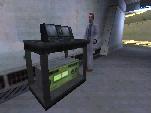Redwood's Half-Life Preview
Genre: First Person 3D Shooter
Design Company: Valve Software
Publisher: Sierra
Expect it in stores: Summer (U.S.) '98
IntroductionYou have heard it all before; our FPS has great AI, great graphics, and immersive gameplay. Sure, some have gorgeous graphics, or even somewhat immersive gameplay, but can they deliver it all? Not so far, especially not in the AI department. Even Unreal's AI, while better than anything before, is not much more than good strafing and the ability to go across a water-filled canal to get to you. I believe Half-Life will change that this summer with AI that has to be seen to be believed. Valve Software was kind enough to fly me to their offices in the constantly overcast Seattle, Washington area. Let me tell you what I experienced of the game during the several days spent with Valve's very personable employees. After that, we will see if you agree with me. I will tell you about the best AI ever seen and gorgeous graphics--among other things--that help make this game extremely immersive.
The StoryWhile there is more shoot-em up gore than any other previous title in its genre, Half-Life has a real story. Gasp! "Can it be true?" you say. Not only is it true, but you will be glad it is there, and it will always be on your mind as you play. Sure, one of the best action games of all time, Quake 2, had a background story, but it was more of a necessary evil that you only thought of before the game started. Half-Life's story is integral to what you do and why you do it the entire time. It helps you "become" your character, the game's main character. Marc Laidlaw, the writer of half a dozen novels and the game's story, commented "We wanted players to feel that they were more than just a pair of disembodied eyes and a weapon floating through a cool 3D world. We've been working to create a more traditional sense of character, where you actually become this guy who is struggling to survive an incredibly strange catastrophe."In Half-Life, you play Gordon Freeman, an innocent scientist thrown into savior mode against your will. Normally you are quite a peaceful dude, but people forced to survive can show previously unseen traits. Your job is at a secret government research facility where you are working on a top secret experiment. You start the game on the military-escorted shuttle tram into work, traveling through gorges to the underground Black Mesa Labs research facility somewhere in New Mexico. This morning, you are a little late. Upon arrival, people are yelling at you to get to your station. They've been waiting on you so they can start the experiment. After grabbing your coffee, you rush to your station. The experiment starts, but something quickly goes wrong. The next thing you know, you're groggily opening your eyes. The room does not look the same as it did a few seconds ago. An unpleasant burning odor fills the air and makes the hairs of your neck stand on end. Scorch marks and toppled computer and furniture make it look as if a bomb went off. Blood and dead coworkers litter the room, and coffee drips off the desks. You wander out into the hallways to see if maybe you are dreaming or if this calamity was somehow isolated to your area, only to find that this is no dream and every where you see the same grim scene. You sense that you must get out to the surface immediately. That is where your real adventure begins. Fortunately though, not everybody is dead; there are others who may be able to help you--or they may try to end your once simple life. Marc adds "As Gordon works his way through the Black Mesa facility, learning more than anyone about the nature of the disaster, he becomes increasingly important-as a character, and especially as a target. On the other hand, although Half-Life has a coherent storyline running through it, there are some amazing things computer games can do which traditional story forms (such as books and movies) cannot. Our plot unfolds not through storytelling, but through storydoing. The story is embedded in the action: It happens because you are there, doing things to save your skin."
|
 Scientist Near Equipment Cart |